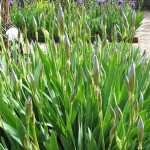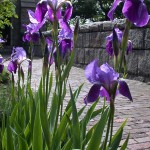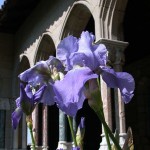 |
 |
 |
Above, left and center: Blue-white orris and deep purple iris blooming simultaneously in Bonnefont Cloister garden. In the Middle Ages, the aromatic rhizomes of orris (Iris germanica var. florentina) were exploited for their fragrance. The purplish juice squeezed from the flowers of Iris germanica was mixed with alum to make a green used in manuscript illumination. Right: The beautiful and sweetly scented Iris pallida blooming in Trie Cloister garden.
And I must not pass you by, my iris, in silence.
Latin, that rich and eloquent tongue, has given you
The name Gladiola, made from its word for a sword.
For me at the start of summer you put forth
The beauty of your purple flower. . . .. . . With your help too
The laundryman can stiffen his shining linen
And scent it sweetly.???Excerpts trom the Hortulus of Walahfrid Strabo (ca. 808???849), translated by Raef Payne.
Due to the extraordinarily warm temperatures in early April, many plants bloomed as much as a month early this spring, and out of their usual sequence. Some plants that ordinarily bloom in succession bloomed simultaneously, including our beautiful bearded iris.
We grow three types of bearded iris in the medieval gardens. They usually bloom in progression, from early May through early June. The bluish-white orris (Iris germanica var. florentina), grown in the bed devoted to aromatic plants in Bonnefont garden, is ordinarily the first to flower. The orris is followed by the deep violet iris (Iris germanica) grown in the bed dedicated to plants used in medieval arts and crafts. Iris germanica is a very variable species, and some botanists consider this ancient garden flower to be a fertile hybrid that arose many centuries ago.
The German irises are succeeded by the lovely, large, lavender-blue flowers of the pale iris (Iris pallida) in the millefleurs garden in Trie Cloister. This year, the late-blooming pale iris opened with the other two, and is the only iris still in flower in mid-May.
All three of these irises have the same flower form, although they vary in color. The irises described or depicted in medieval sources range from light to dark and from blue to violet. Named in antiquity for the Greek goddess of the rainbow, the variability of the genus has resulted in an incredible range of color in modern hybrids, although a true red iris has yet to be developed. (A white orris on a red ground was the symbol of the medieval city of Florence, but the colors were later reversed. The Giardino dell Iris in Florence, the largest iris collection in Europe, hosts an International Iris Competition every year and awards a special prize to the iris that most closely resembles that of the city’s coat of arms. For more about flowers used in coats of arms, see Theo Margelony’s post, “The Garden in Heraldry.”)
The rhizomes of all three of our medieval irises are so similar in appearance as to be virtually indistinguishable once they’ve been dug and dried. Although the crushed petals of blue or purple irises was mixed with alum to make an ‘iris green’ used in medieval manuscript illumination, it was the rhizomes of these iris species that were economically important. They were exploited for both their scent and their medicinal properties in antiquity. Orris root was preferred in perfumery and was the basis of a number of famous unguents. The rhizomes of all three kinds seem to have been used interchangeably in the Middle Ages.
Although orris is the most strongly scented of the three, I. germanica and I. pallida were and are used as adulterants in the trade. Orris is still of economic importance and is an expensive commodity, as anyone who has purchased the powdered root for use as a fixative in potpourri knows. The fresh rhizomes of iris, which are at least three years old before they are dug, do not develop their characteristic scent of violets until they have been dried and aged for at least two and up to five years. The rhizomes are then distilled, and a thick, oily compound known as iris butter is produced. Iris perfumes are still made today, although the natural product is often synthesized. For a number of fascinating posts on the history and chemistry of iris fragrances, visit http://perfumeshrine.blogspot.com.
The origins, history, uses, and meanings of the iris are too complex to be addressed in a single post, but the following links provide more information on knowing and growing these ancient and beloved garden plants: American Iris Society; British Iris Society; Italian Iris Society.
???Deirdre Larkin
Sources:
Anderson, Frank J., ed. “Herbals through 1500,” ??The Illustrated Bartsch, Vol. 90.?? New York: Abaris, 1984.
Grieve, Maude. A Modern Herbal. 1931. Reprint: New York: Dover Publications, 1971.
Tags: iris, Iris germanica, Iris pallida, orris, Walahfrid Strabo

May 27, 2010 at 9:47 pm
Why is the Strawberry Tree, the arbutus unedo, named for the fruit?
July 5, 2010 at 9:35 am
iris, especially the wild blue flag, are amazing plants. i will try to make iris green next year!